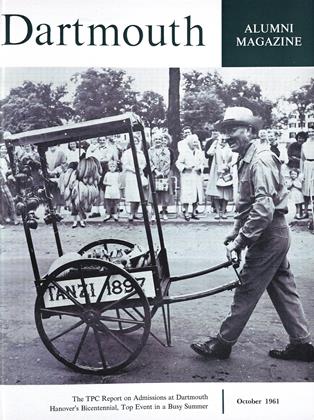Music, Arts, Classes, Conferences ...
Biggest Event of the Sum — HANOVER'S BICENTENNIAL
There was also plenty of activityon the College constru
Bud Weymouth '20 on duty at the campus information booth which he has managed each summer for many years.
A student guide conducting a group ofsummer sightseers on a College tour.
The campus softball diamond where student games are played eachspring is taken over by boys' camps for their annual tournament.
The Estival Quartet, which presented five concerts in its1961 summer series, is an increasingly popular attraction.
Prof. James D. McCallum lecturing on literature to Bell Telephone executives.
Another educational program sponsoredby the College was the course in computing machines for math instructors.
Alumni Gymnasium early in August was the scene of theannual fair of the League of New Hampshire Arts and Crafts.
The Russian Institute, attended byfifty secondary school teachers, wasin session for nearly eight weeks.
To compare notes on the latest ionosphere research, a small groupof outstanding scientists from England, Canada, Japan and SouthAfrica met with Professor Millett Morgan of Thayer School in July.
The College's float in the July 4 parade saluted Hanover asthe second home for Dartmouth men around the globe.
Prof, and Mrs. Russell Stearns '37 lead afile of Colonial ladies and gentlemen whowere representing the churches of Hanover.
Rev. Wilbur I. Bull 09 preaching at the Sunday servicein Rollins Chapel that opened the Bicentennial program.
The Hanover Historical Society's entry was an old Concord Coach with Dean Emeritus McDonald as the hornsman.
Assistant Dean Henry M. Helgen, powdered and bewigged,greets Hanoverians attending the Rollins Chapel service.
Prof. John B. Stearns 'l6, one of the marshals, hearsa fife and drum concert while waiting for the parade.
One of the features of the climactic day of July 4 wasa picnic, speaking program and field day on the campus.
Professor Neale, master of ceremonies, leads the applausefor Edward C. Lathem '51, Bicentennial program chairman.
An aerial view of the Hopkins Center, lookingeast with Lebanon Street at lower right, indicates good progress in construction and gives anidea of the Center's huge size. Below, is a frontview of the Center as seen from the campus.
An aerial view of the Hopkins Center, lookingeast with Lebanon Street at lower right, indicates good progress in construction and gives anidea of the Center's huge size. Below, is a frontview of the Center as seen from the campus.
The new mathematics and psychology buildings,north of Baker Library (seen in foreground),are tearing completion and will be dedicatedin November. The ground view below shows theglassed-in connecting corridors and the greenand white exterior tiles which make the newunit the most colorful spot on the campus.
The new mathematics and psychology buildings,north of Baker Library (seen in foreground),are tearing completion and will be dedicatedin November. The ground view below shows theglassed-in connecting corridors and the greenand white exterior tiles which make the newunit the most colorful spot on the campus.
Three new dormitories were ready for occupancy when the collegeyear began last month. Located west of Tuck and Thayer Schools(the Connecticut River can be seen), the residence halls are presently named Wigwam, North Wigwam, and South Wigwam Hallsin memory of Wigwam Circle, formerly located on the site. Atright, beds are being delivered by a truck perhaps appropriatelylabeled in view of the large freshman contingent in the new dorms.
Three new dormitories were ready for occupancy when the collegeyear began last month. Located west of Tuck and Thayer Schools(the Connecticut River can be seen), the residence halls are presentlynamed Wigwam, North Wigwam, and South Wigwam Hallsin memory of Wigwam Circle, formerly located on the site. Atright, beds are being delivered by a truck perhaps appropriatelylabeled in view of the large freshman contingent in the new dorms.
Work on the Nervi-designed field house at thesouth end of Memorial Field has mainly had todo with the foundations. The railroad track wasbuilt for the huge crane that will lift precastunits into place, working from end to endand on both sides. The photo above shows anearly stage of the molds in which the diamond-shapedconcrete roof units will be cast.
Work on the Nervi-designed field house at thesouth end of Memorial Field has mainly had todo with the foundations. The railroad track wasbuilt for the huge crane that will lift precastunits into place, working from end to endand on both sides. The photo above shows anearly stage of the molds in which the diamond-shapedconcrete roof units will be cast.
 View Full Issue
View Full Issue
More From This Issue
-
 Feature
Feature... AND MANY DARTMOUTH YESTERDAYS
October 1961 By Edward Connery Lathem '51 -
 Feature
FeatureWHY a Hopkins Center at Dartmouth?
October 1961 -
 Feature
FeatureWHAT OF ADMISSIONS AT DARTMOUTH?
October 1961 -
 Feature
FeatureADMISSIONS – As Seen at the President's Desk
October 1961 By J.S.D. -
 Article
ArticleTHE FACULTY
October 1961 By GEORGE O'CONNELL -
 Class Notes
Class Notes1921
October 1961 By JOHN HURD, HUGH M. MCKAY
Features
-
 Cover Story
Cover StorySEALED FILES
MARCH | APRIL 2014 -
 Feature
FeatureA Life Overboard
May/June 2005 By BRYANT URSTADT ’91 -
 Feature
FeatureThe Reluctant Luddite
Sept/Oct 2011 By DIRK OLIN ’81 -
 Cover Story
Cover StoryNo Script Required
SEPTEMBER | OCTOBER 2017 By Jennifer Wulff ’96 -
 Feature
FeatureThe First 25 Years of the Dartmouth Bequest and Estate planning Program
September 1975 By Robert L. Kaiser '39 and Frank A. Logan '52 -
 Feature
FeatureProphecy in Painting
JUNE 1967 By ROBERT REID and DOROTHY BECK






